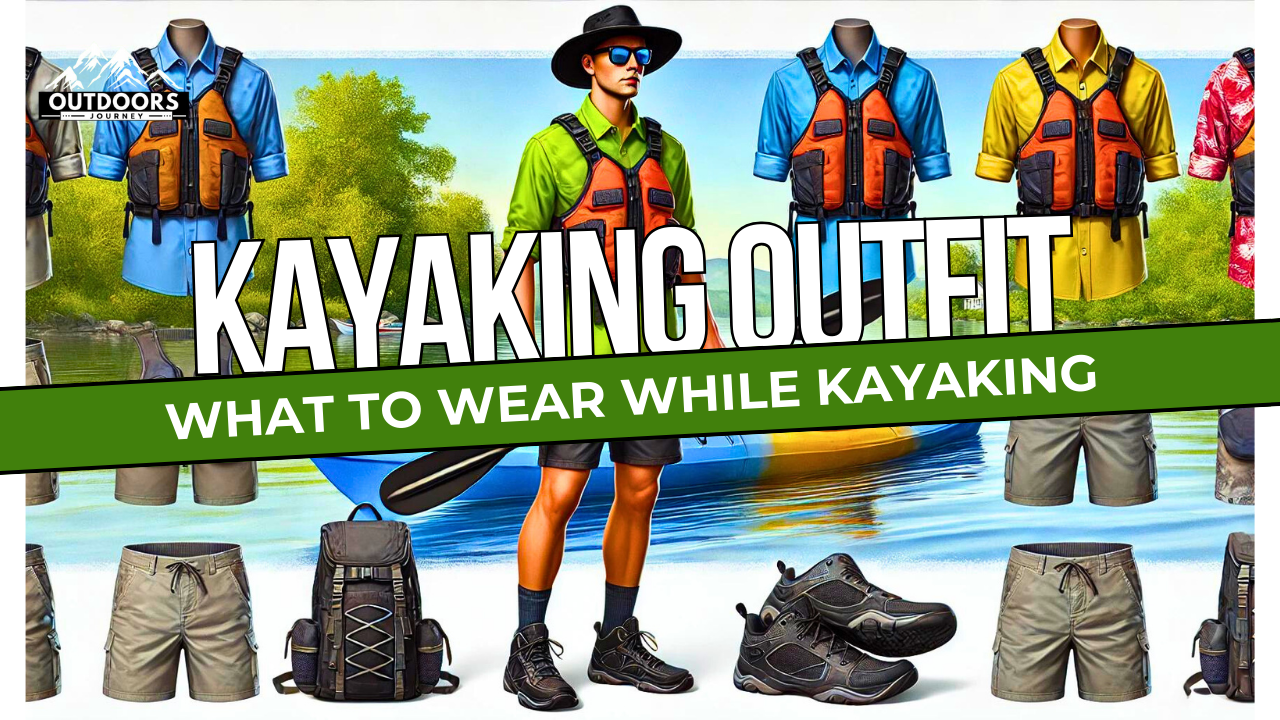Imagine gliding over a calm lake as the sun kisses your skin, the gentle splash of water at the side of your kayak igniting your sense of adventure. But before you start, you might wonder what to wear. The right clothes not only make you more comfortable but also protect you from the water’s surprises. You’ll need something that keeps you warm from unexpected splashes and cool from the sun’s heat. Let’s look at the key clothing items that will keep you safe and ready for anything.
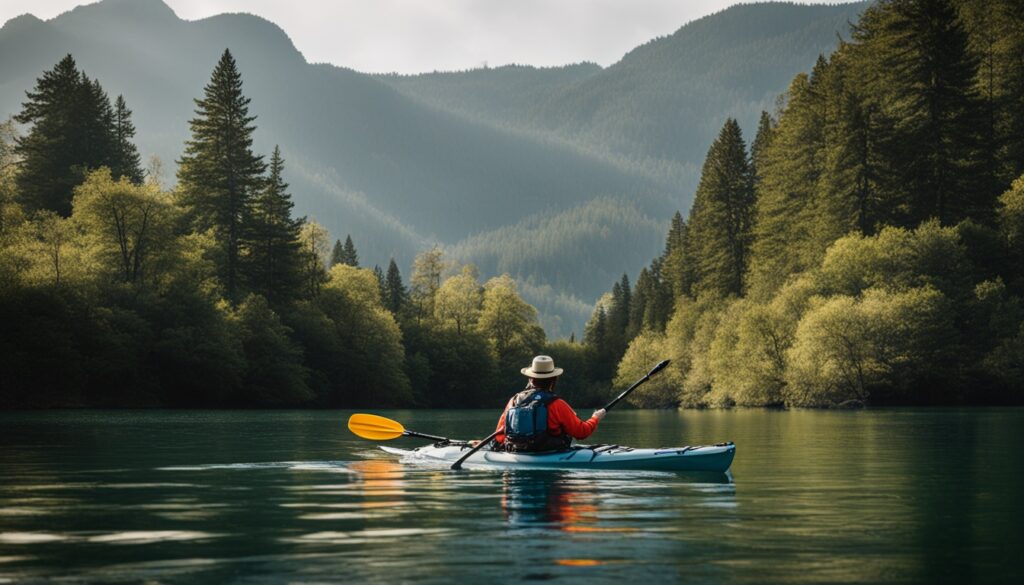
Key Takeaways
- Choosing the right kayaking attire is crucial for your comfort and safety.
- Dress according to water temperature to prevent sudden chills.
- Layering techniques help regulate body temperature effectively.
- Investing in neoprene materials can prevent chafing during your adventure.
- Always prioritize safety by wearing a properly fitted life jacket.
- 1 Understanding the Importance of Proper Kayaking Attire
- 2 Key Considerations for Kayaking Clothing
- 3 What to Wear While Kayaking: Layering Techniques
- 4 Footwear Options for Kayaking
- 5 Hydration and Sun Protection
- 6 The Role of Personal Flotation Devices (PFD)
- 7 Cold Weather Kayaking Gear
- 8 Warm Weather Kayaking Essentials
- 9 Choosing the Right Paddle Jacket
- 10 Tips for Longer Kayaking Trips
- 11 Best Fabrics for Kayaking Clothing
- 12 Safety Tips for Kayaking Attire
- 13 Final Thoughts on Kayaking Clothing
- 14 Conclusion
- 15 FAQ
- 16 Source Links
Understanding the Importance of Proper Kayaking Attire
Wearing the right clothes is key to a great kayaking experience. The right gear boosts your comfort and safety on the water. It should protect you and let you move easily. This way, you can enjoy your paddle without feeling uncomfortable.
Keeping your body temperature in check is crucial. In cold water, a wetsuit is a good choice. It keeps you warm by letting a thin layer of water stay close to your skin. For really cold water, dry suits are better. They keep you dry and warm with the right layers underneath.
Think about how you layer your clothes. Start with quick-drying base layers that pull moisture away from your skin. Add mid-layers like fleece or wetsuits for extra warmth. The right clothes protect you from the elements and keep you safe and warm on your trip.
Protecting yourself from the sun is also vital. Hats, sunglasses, and sunblock prevent sunburn and heat exhaustion. Always carry a Coast Guard-approved Personal Flotation Device (PFD). A PFD that fits well is key to your safety while kayaking. Wearing the right gear makes your time on the water more enjoyable and safe.
Key Considerations for Kayaking Clothing
When you’re getting ready for kayaking, think about the water and air temperature, and the weather. These things affect what you should wear to stay safe and comfy. Dressing right makes your kayaking trip better, letting you enjoy the ride more.
Water Temperature
The water’s temperature is key when choosing what to wear. For warm waters, go for quick-drying fabrics like nylon. They keep you cool and dry. But for cold waters, you’ll need something warmer.
Wetsuits or dry suits are perfect for keeping warm and staying dry. They’re a must for staying comfy in the cold.
Air Temperature
The air temperature also matters for your outfit. On hot days, wear light, moisture-wicking clothes to stay cool and dry. These clothes help sweat evaporate fast.
On cold days, layer up. Use synthetic or merino wool base layers to keep warm. Add fleece for extra heat. And don’t forget a waterproof outer layer to keep out the wind and rain.
Weather Conditions
Weather can change fast while kayaking. Always bring extra layers, like a waterproof jacket or poncho for cold conditions. A hat and sunglasses protect you from the sun.
Wind and rain can surprise you, so wear quick-drying and waterproof clothes. Being prepared lets you safely and comfortably enjoy your paddle in any weather, especially in harsh and cold conditions.
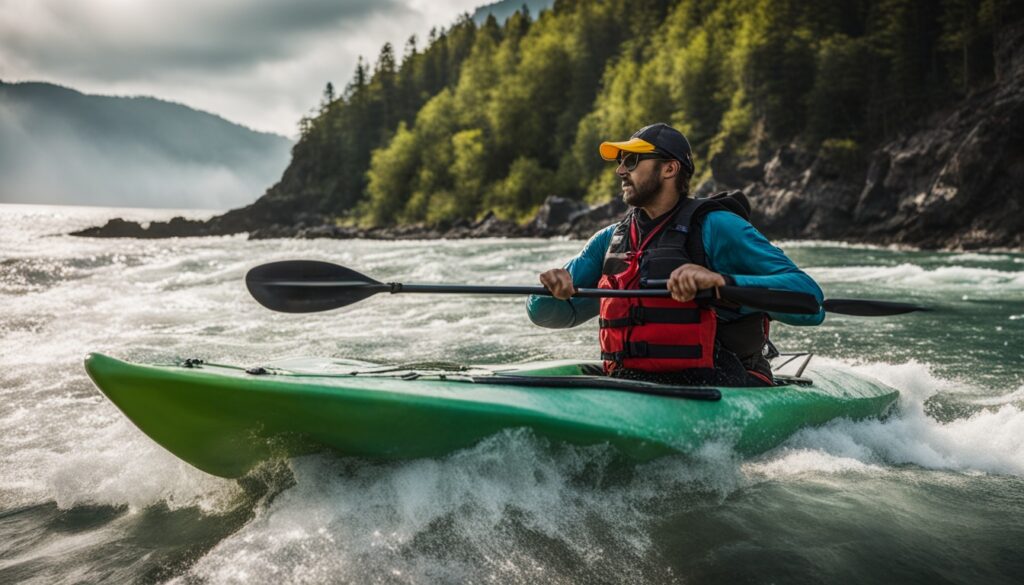
What to Wear While Kayaking: Layering Techniques
Layering is key for comfort and safety in kayaking. Use base, mid, and outer layers to adjust to changing temperatures and weather. Each layer helps control your body temperature and keeps you dry.
Base Layers
Your outfit begins with base layers. These should be made from moisture-wicking materials to keep you dry and comfy. Choose rashguards or quick-drying tops to keep sweat away. Avoid cotton because it absorbs moisture and takes a long time to dry.
For warmer weather, wear swim trunks or breathable leggings for extra comfort.
Mid Layers
Mid-layers add warmth and insulation. You can wear fleece jackets or lightweight sweaters under your outer layers. For cold water, consider thicker mid-layers or a thin wetsuit.
These choices help keep your body heat in and protect you from wind chill. The right mid – layer makes a big difference in how comfortable you are.
Outer Layers
Outer layers shield you from the elements. Choose a waterproof jacket, a durable dry suit, or a breathable paddling jacket. These should have gaskets to keep water out and keep you warm.
For serious kayakers, GoreTex outer layers are a great choice. They help keep your body heat in and keep you stable during activities.
| Layer Type | Purpose | Recommended Fabrics | Examples |
|---|---|---|---|
| Base Layer | Moisture-wicking, comfort | Nylon, polyester, lycra | Rashguards, quick-dry tops |
| Mid Layer | Insulation, warmth | Fleece, synthetic blends | Fleece jackets, lightweight sweaters |
| Outer Layer | Protection from elements | GoreTex, waterproof materials | Waterproof jackets, dry suits |
Using the right kayaking layers makes your trip more comfortable and safe. Think about your kayaking environment to pick the best layering techniques for you.
Footwear Options for Kayaking
Choosing the right kayaking footwear is key for your comfort and safety. You have many options based on the conditions and where you’re kayaking. Knowing about the different types will help you pick the best for your adventures.
Water Shoes and Sandals
Water shoes are great for protection and dry fast, perfect for moving between water and land. They should have good rubber traction for safety on slippery spots. Sandals are also a top pick, especially when it’s warm. They’re light, breathable, and dry fast, keeping you comfy.
For sandals, pick ones with secure straps to prevent them from coming off in the water. You can also use rubber overshoes over other shoes for more protection, especially in damp places.
Neoprene Booties
Neoprene booties are a good choice for cold weather. They keep your feet warm and are great for kayaking in chilly waters. They might not dry fast, but they keep you warm.
If it’s really cold, wear wool or Gore-Tex socks under your neoprene for extra warmth and moisture control. Neoprene and mesh are often used in kayaking shoes for drying fast and being breathable. This keeps your feet comfortable during your trip.
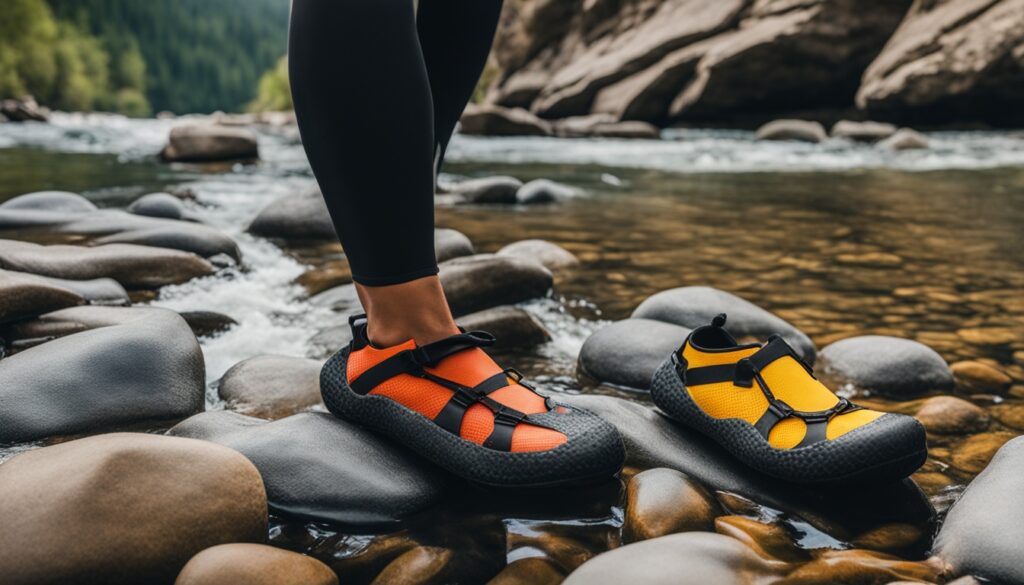
Hydration and Sun Protection
Being safe on the water is more than just about your gear. It’s important to stay hydrated and protect yourself from the sun. If you ignore these, you might feel bad or even get sick while kayaking. Taking care of these areas makes your adventure better, letting you enjoy nature’s beauty.
Choosing the Right Hat and Sunglasses
A wide-brimmed sun hat is key for protecting your ears, face, and eyes from UV rays. Make sure your hat has a three-inch brim. Then, wear polarized sunglasses to block glare from the water, especially on sunny days. Don’t forget sunglasses with UV protection to keep your vision safe and comfortable.
Applying Sunscreen Wisely
Using sunscreen is crucial for sun safety. Pick a broad-spectrum sunscreen with SPF 30 or higher. Put it on every five hours or after swimming to keep it working well. For lots of sun time, use more protective layers.
Long-sleeved shirts with a UPF of 50 blocks 98% of the sun’s rays, letting only 2% through. Sungaiters and fishing sun gloves protect your neck and hands too. Brands like Simms, Orvis, and Huk have great options for kayakers who care about the sun.
| Sun Protection Gear | Key Features |
|---|---|
| Sun Hat | Wide brim (3 inches or more) for face and neck protection |
| Sunglasses | Polarized lenses to reduce glare and UV protection |
| Sunscreen | Broad-spectrum SPF 30+; reapply every five hours |
| Long-Sleeved Shirt | UPF 50, blocks 98% of UV rays |
| Sungaiters | Protects neck from UV exposure |
| Fishing Sun Gloves | UPF 50, helps shield hands from sun |
Keeping hydrated and protected from the sun keeps you energized and safe while kayaking. Drink lots of water or drink with electrolytes, especially when it’s sunny. These steps will let you enjoy the water without worry.
The Role of Personal Flotation Devices (PFD)
Personal flotation devices are key to kayaking safety. When you’re on the water, picking the right life jacket and making sure it fits right is crucial. It can save your life in an emergency. Knowing the different types of PFDs helps keep you safe while you enjoy the water.
Types of Life Jackets
There are five main types of personal flotation devices, each made for different activities and places. For fun on the water, Type II and Type III life jackets are top choices. They’re comfy and keep you buoyant.
Life jackets have changed a lot over time. They went from cork-filled ones used by the British Royal Navy in the 1800s to today’s foam ones. Now, they’re made for all-day wear and make you want to keep them on, which helps in emergencies.
Life jackets are a must-have for boats far from shore, where help might take a while. Ships and ferries carry them for safety.
Fitting Your PFD Properly
Getting your PFD to fit right is key for safe kayaking. It should be snug but comfy, letting you move freely. Always check the fit before you go out. If your PFD doesn’t fit right, it won’t work as it should in an emergency.
In Connecticut, kayakers must wear PFDs from October to May. This rule shows how important being ready for surprises is, whether you’re close to shore or out in the open. Wearing a life jacket is a choice, but it could save your life.
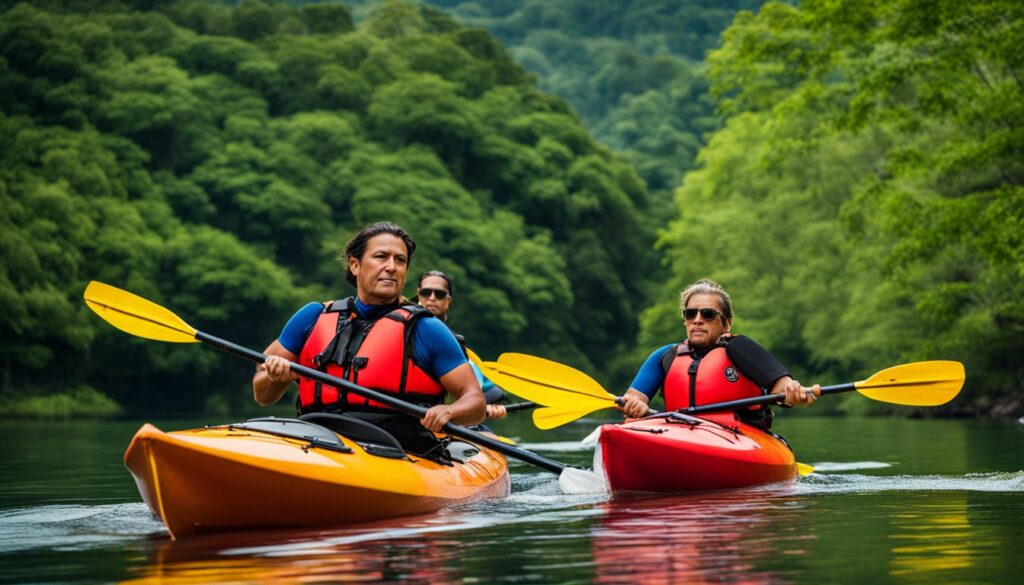
| Type | Design | Best Use |
|---|---|---|
| Type I | Offshore Life Jacket | Open, rough waters |
| Type II | Nearshore Buoyant Vest | Calm inland waters |
| Type III | Flotation Aid | Water sports, recreational activities |
| Type IV | Throwables | Quick rescue |
| Type V | Special Use | Specific activities (e.g., kayaking, windsurfing) |
Cold Weather Kayaking Gear
When you go kayaking in the cold, picking the right gear is key for safety and comfort. Knowing the difference between drysuits and wetsuits, and how to pick thermal layers, makes a big difference. It changes how you feel on the water.
Drysuits vs. Wetsuits
Drysuits keep water out completely and let you layer up underneath. This is crucial in cold weather kayaking, where a little water can make you lose a lot of heat. Wetsuits let water in but warm up a thin layer of it for insulation. They’re cheaper and last longer but aren’t as good below 50°F. Drysuits are better for colder weather.
Choosing Thermal Layers
Layering is key to staying warm while kayaking. Here’s how to do it:
- Inner Layer: Use synthetic fabrics like polypropylene to keep moisture away from your skin.
- Second Layer: Choose insulating materials like fleece or wool for warmth without bulk.
- Outer Layer: A dry suit or paddling jacket keeps wind and water out, keeping you dry and comfy.
Don’t forget a waterproof hat or hood to keep your head warm. Boots or gloves for cold weather can also make your trip better. Kokatat and Immersion Research make great dry suits. For the inner layer, synthetic options like Patagonia Capilene are good for those who don’t like wool. Below 50°F, always choose a drysuit to avoid hypothermia risks.
Warm Weather Kayaking Essentials
When you go kayaking in warm weather, what you wear is key to staying comfy and safe. Choosing the right gear means you’ll stay cool and protected from the sun. It’s important to focus on quick-drying fabrics and UPF-rated clothing for a better experience.
Quick-Drying Fabrics
Choosing quick-drying fabrics is a must for kayaking. A long-sleeved, button-up shirt that dries fast is great for comfort and safety. Quick-dry shorts or pants, or even pants that zip off, are great for changing weather. Don’t forget breathable underwear to prevent chafing and keep you dry.
UPF-rated Clothing
UPF-rated clothing is also key for kayaking. Fitted sun shirts protect you from UV rays, so you can enjoy the sun safely. Adding a brimmed cap and sunglasses with retainers boosts your sun protection. These items are crucial for a comfortable and safe kayaking trip.
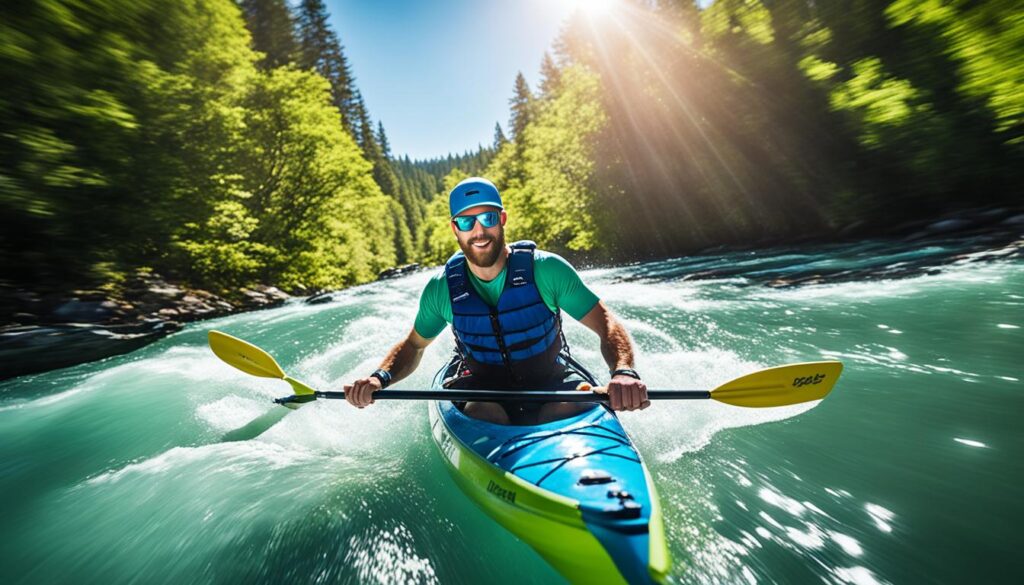
Choosing the Right Paddle Jacket
Choosing the right paddle jacket is key for a great kayaking experience. It’s important in different weather conditions. A splash jacket keeps water out but lets moisture escape, making you more comfortable.
For intense paddling or unpredictable weather, breathable waterproof jackets are a smart choice. They can make a big difference in your comfort.
Benefits of Splash Jackets
A splash jacket protects you from wind, rain, and water splashes. It’s crucial for staying dry. A good fit means your body temperature stays in check, letting you enjoy the ride.
Breathable and Waterproof Options
Look for breathable waterproof jackets for comfort during your paddle. Choose materials that let air in but keep water out. Brands like NRS, Kokotat, and Level Six have great options.
Features like adjustable cuffs and a drop tail improve fit and keep water out. The right paddle jacket can make kayaking better.
Tips for Longer Kayaking Trips
Planning longer kayaking trips means making sure you’re comfortable. Weather can change fast, so packing extra layers is key. With the right clothes and gear, you’ll stay happy, no matter the weather.
Extra Layers for Comfort
Having extra layers is vital for staying warm and dry. In temperatures of 65-70 Fahrenheit, wear thermal or water-resistant clothes. A Farmer John wetsuit is a good choice, costing less than $50.
For colder water, layer with quick-drying shirts and ripstop BDU pants. Brands like NRS offer hydroskin options that are flexible and don’t add too much bulk.
Additional Accessories
Getting the right kayaking accessories makes a big difference on long trips. Waterproof bags are a must for keeping your stuff safe. Neoprene gloves and waterproof boots keep you warm when it’s cold.
Lightweight rash guards protect you from the sun and keep you cool. And don’t forget lip balm to prevent windburn. These accessories will make your longer kayaking trips more enjoyable.
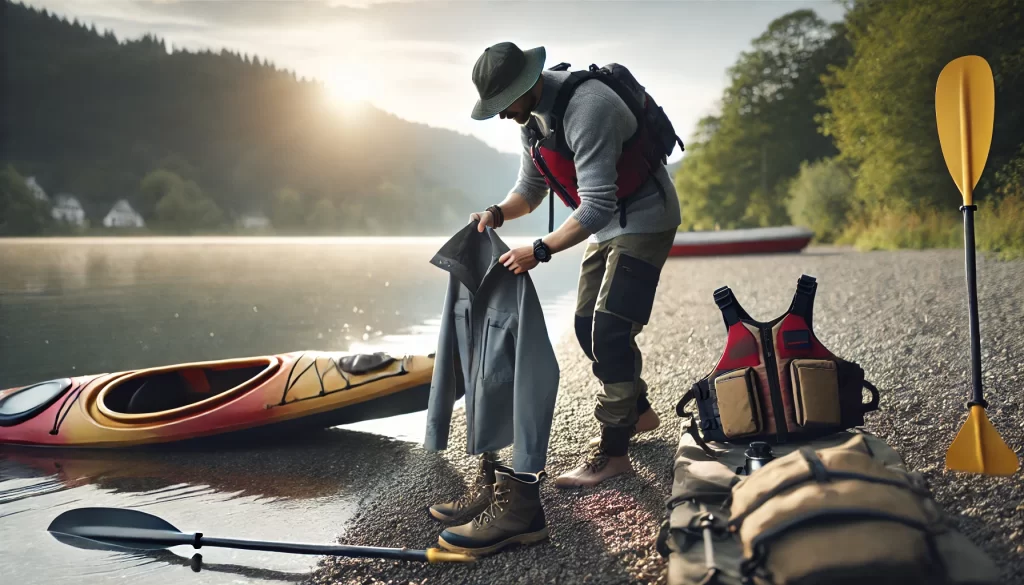
| Accessory | Function | Recommended Brands |
|---|---|---|
| Waterproof Bag | Protects electronics and valuables | SealLine, NRS |
| Neoprene Gloves | Provides warmth and grip | NRS, Immersion Research |
| Rash Guard | Offers UV protection and cooling | Bomber Gear, NRS |
| Dry Bag | Store additional clothing and gear | REI, Outdoor Research |
Best Fabrics for Kayaking Clothing
Choosing the right fabric is key for a great kayaking trip. The best fabrics make you comfortable, safe, and perform better. Knowing which materials to pick can greatly improve your time on the water.
Avoiding Cotton and How it Affects Performance
When you’re getting ready for kayaking, avoiding cotton is a must. Cotton soaks up water, making you cold and uncomfortable. It also takes a long time to dry, which can lower your body temperature and hurt your performance.
Instead, go for synthetic materials like polyester or nylon. These fabrics dry fast, pull moisture away from your skin, and keep you comfortable. This means you’ll stay dry and focused on your paddling.
Choosing Synthetic or Wool Materials
Synthetic materials are a top pick for kayakers because they dry quickly and breathe well. Brands like Under Armour and Columbia offer great options, such as Heat Gear t-shirts and Omni Shade long-sleeve shirts. These can be worn under a PFD for extra sun protection.
Or, consider wool materials like Merino wool. It’s great for keeping you warm while still being breathable when wet. This is super useful in changing weather.
| Fabric Type | Benefits | Drawbacks |
|---|---|---|
| Cotton | Soft and comfortable | Absorbs moisture, stays wet, causes discomfort |
| Synthetic (Polyester, Nylon) | Quick-drying, moisture-wicking, durable | Can be less breathable in extreme heat |
| Wool (Merino) | Breathable, insulating, natural odor resistance | Can be pricier than synthetic options |
Picking the right fabric can make your kayaking trip better. Stay comfy and safe by choosing fabrics made for water activities.
Safety Tips for Kayaking Attire
Your safety in kayaking depends a lot on the right clothes. Knowing how to get ready can change your experience on the water. Start by using waterproof bags to keep things like phones, wallets, and extra clothes dry. These bags help keep important items safe, even if you get splashed. Making sure your kayaking attire safety is key to staying comfortable and doing well.
Using Waterproof Bags for Valuables
There are many waterproof bags to choose from, perfect for keeping your stuff safe from water. Here are some good options:
- Packs: Waterproof backpacks or dry bags are great for carrying big items.
- Pouches: Small, sealed pouches work well for things like electronics and wallets.
- Wrist Wallets: Waterproof wrist wallets let you easily get to what you need without losing safety.
Readying Yourself for Submersion
Even if you don’t plan to fall in the water, wearing the right kayaking clothes helps you react fast and stay warm. Here’s how to get ready:
- Choose synthetic fabrics like neoprene or polyester that dry fast and keep you warm even when wet.
- Layer up. Use moisture-wicking base layers to stay comfy if you get wet.
- Go for the right shoes like neoprene booties or water shoes. They protect your feet and help you grip the kayak.
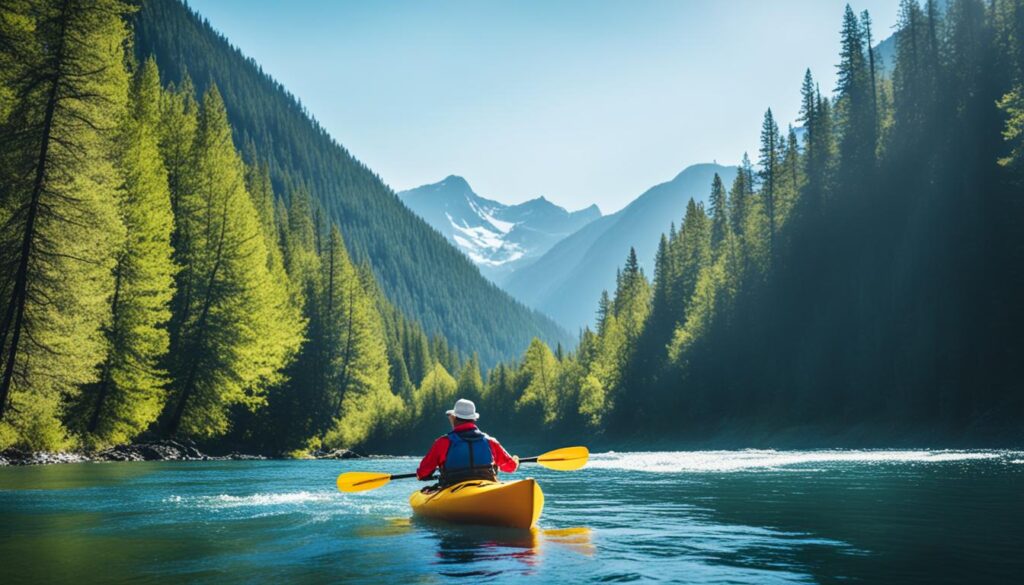
Final Thoughts on Kayaking Clothing
Wearing the right kayaking clothes makes your experience better and keeps you safe. A good kayaking clothing summary means thinking about comfort, function, and staying safe from the weather. Always check the weather and water type before you go kayaking. Knowing how to layer your clothes helps you stay comfy during your trip.
Choosing the right materials is key to enjoying the water. Stay away from cotton because it soaks up water and takes away your body heat. Go for lightweight, quick-drying clothes that keep you warm and dry. Learn about tips for kayaking attire like wearing thin layers. This makes drying off faster if you fall in the water.
A personal flotation device (PFD) is very important. The U.S. Coast Guard says most drowning victims weren’t wearing one. Choose a Type III or Type V PFD made for paddlers.
Always check the weather forecast before you go kayaking and dress accordingly. A windbreaker, the right shoes, and sun protection are key for a good time. By following these tips, you’ll stay safe and enjoy kayaking more.
| Kayaking Conditions | Clothing Recommendations |
|---|---|
| Cold Weather | Wetsuit or dry suit, layered non-cotton base, and mid-layers such as fleece |
| Warm Weather | Light layers or swimsuits, quick-dry fabrics like board shorts and rashguards |
| Sunny Conditions | Sunhat, polarized sunglasses, and reef-safe sunscreen |
| Windy Conditions | Windbreaker and layered clothing for body heat retention |
Conclusion
As you get ready for your next kayaking trip, remember the key clothing tips for safety and fun. Choosing the right clothes is key for staying comfortable in different weather. Start with layers like moisture-wicking T-shirts, warm fleece, and breathable rain jackets.
Protecting yourself from the sun’s harmful rays is also important. Consider wearing UPF-rated clothes like the NRS Men’s Rashguard or the NRS Women’s Guide Shorts. These clothes are comfy and keep you safe, letting you enjoy your time on the water.
Don’t forget about the right shoes and accessories. From hiking shoes to neoprene boots with a thermal lining, the right footwear makes a big difference. By choosing clothes that are both functional and comfortable, you’re ready for your next adventure. You’ll be confident and ready to take on whatever nature throws your way.
FAQ
What should I wear for a kayaking trip?
How do I choose the right footwear for kayaking?
Why is layering important while kayaking?
What type of sun protection do I need while kayaking?
Do I need a life jacket while kayaking?
What gear do I need for cold weather kayaking?
What should I consider for warm weather kayaking?
How do I ensure comfort on longer kayaking trips?
What fabrics are best for kayaking clothing?
How can I keep my valuables safe while kayaking?
Source Links
- What To Wear For Kayaking Men and Women: An Ultimate Paddling Dress Code – https://www.gilisports.com/blogs/kayaking/what-to-wear-kayaking-for-men-and-women?srsltid=AfmBOopGYvo7lO_NS-pS3FoDI6oH9vQyzINiZEfYfXTqfha9wBpND1oP
- What to Wear Kayaking in the Summer | Summer Kayaking Clothes – https://www.logkayakrack.com/what-should-i-wear-kayaking-in-the-summer/
- What To Wear For Kayaking Men and Women: An Ultimate Paddling Dress Code – https://www.gilisports.com/blogs/kayaking/what-to-wear-kayaking-for-men-and-women?srsltid=AfmBOorKy5-renZLej22uttgiYJVrDR2q47zidZFBkm88Zkj_HOHjDTv
- What to Wear Kayaking in Any Temperature – https://www.mountainkhakis.com/blogs/news/what-to-wear-kayaking?srsltid=AfmBOooycrzALFIccAUgquuHcBL8eWj9A9z0lYKOE_hYyTwmWcmf8oBj
- How to Dress for Kayaking – https://paddling.com/learn/how-to-dress-for-kayaking
- A Complete “What to Wear Kayaking Review” for the Pacific Northwest – https://www.wildrootjourneys.com/2020/10/30/a-breakdown-of-what-to-wear-kayaking-in-the-pacific-northwest/
- What to Wear Kayaking in Any Temperature – https://www.mountainkhakis.com/blogs/news/what-to-wear-kayaking?srsltid=AfmBOorkPUIddVt_8Tnun2dJ9BCVvc5EA-2q_qRn1oZhY0X-QW8ZY-VV
- What to Wear Kayaking | Complete Guide + Learn to Layer – https://www.divein.com/kayaking/what-to-wear-kayaking/
- What To Wear For Kayaking Men and Women: An Ultimate Paddling Dress Code – https://www.gilisports.com/blogs/kayaking/what-to-wear-kayaking-for-men-and-women?srsltid=AfmBOor1St959mXZbWurPPWSd9JS1rTt4qubE4WeH5-m-YwgUnEMD3zp
- How to Dress for Kayaking – https://www.baysports.com.au/blogs/blog/how-to-dress-for-kayaking
- What shoes do you wear kayaking? – Blazin’ Paddles – https://www.blazinpaddles.com/what-shoes-do-you-wear-kayaking/
- What Shoes to Wear Kayaking: A Guide to Footwear for Paddling | Vessi Footwear – https://vessi.com/blogs/the-forecast/what-shoes-to-wear-kayaking-a-guide-to-footwear-for-paddling
- Sun Protection for the Kayak Angler – https://www.fishtalkmag.com/blog/sun-protection-kayak-angler
- Sun protection while kayak fishing. – https://www.michigan-sportsman.com/threads/sun-protection-while-kayak-fishing.567906/
- The difference between Life Jackets and Personal Flotation Devices (PFDs) – https://mustangsurvival.com/blogs/resources/the-difference-between-life-jackets-and-personal-flotation-devices-pfds?srsltid=AfmBOorKcjWqmituhoRhOwKHgB-DyAC7484nwEC0rm_os8yPmItq5h5B
- Why Wear a Life Jacket? – https://guillemot-kayaks.com/why-wear-life-jacket
- How to Dress for Cold-Water Paddling – https://paddleboston.com/resources-section/how-to-guides/dress-cold-water-paddling/
- Dressing for Cold Weather Paddling – https://paddling.com/learn/dressing-for-cold-weather-paddling
- Winter Kayaking: Best Gear & How to Layer – https://madelinemarquardt.com/winter-kayaking-best-gear-how-to-layer/
- Sea Kayaking clothes for Warm Weather – http://www.wayfinderali.com/2009/12/paddling-clothes-for-warm-weather.html
- What to Wear Kayaking: Guide to All-Season River Paddling – RiverBent – https://riverbent.com/what-to-wear-kayaking-rivers/
- What To Wear Kayaking – Helpful Guide to Kakaying Clothes – https://lowbudgetadventurer.com/what-to-wear-kayaking/
- Paddling Clothes for Every Kind of Weather – RiverBent – https://riverbent.com/paddling-clothes-for-every-kind-of-weather/
- Kayak Clothing Essentials for Every Paddler – PADDLING 101 – https://www.paddling101.com/kayak-clothing/
- KÜHL’s The One: Best Jacket for Canoeing? – https://www.paddlinglight.com/articles/kuhls-the-one-best-jacket-for-canoeing/
- Clothing advice for new kayakers – https://forums.paddling.com/t/clothing-advice-for-new-kayakers/40480
- Clothing to wear while kayaking? – https://forums.paddling.com/t/clothing-to-wear-while-kayaking/51055
- For summer kayaking what type of shirt under pfd and shorts – https://forums.paddling.com/t/for-summer-kayaking-what-type-of-shirt-under-pfd-and-shorts/116073
- Ultimate Guide to Kayak Clothing – https://www.kayaks2fish.com/blog/ultimate-guide-to-kayak-clothing/?srsltid=AfmBOoqf7iKUN06b-6jvtiHXoqgtOSWcHmPhgryRdsUXfgZIXEEATKkO
- What To Wear Kayaking: Paddling Dress Code For All Weather Conditions – https://www.watersportswhiz.com/what-to-wear-kayaking/
- Kayaking Clothing Guide: Stay Safe and Comfortable on the Water – https://yak-works.com/blogs/fishing-adventure-kayaks-southport-nc/what-to-wear-kayaking-a-comprehensive-guide-to-staying-comfortable-and-safe
- What to Wear for Fall Paddling – https://coloradokayak.com/blogs/cks-blog/what-to-wear-fall-paddling
- What to Wear When Kayaking – https://www.outdoorlife.com/survival/what-to-wear-when-kayaking/
- What To Wear Kayaking – https://flatwaterkayakclub.com/explore/kayak-clothing
- An Ultimate Guide on What to Wear on Your Next Kayaking Adventure – https://www.gilisports.com/blogs/kayaking/what-to-wear-kayaking?srsltid=AfmBOorErZDC13VOQZe3-V1lGk_FsWXG9XOcjn_R3UNXKsjGuUY8mYbK
- What to Wear Canoeing Tips: Paddle Perfect – https://www.loudonvillecanoe.com/what-to-wear-canoeing/
- The Beginner’s Guide to Kayak Clothing Through the Seasons – https://www.outdoorplay.com/blogs/news/the-beginner-s-guide-to-kayak-clothing-through-the-seasons?srsltid=AfmBOorzMTfisvAIFEICx-2CyQqouS5lMmOBHKCfhTHp52YnynPb1pdk
- Sit On Top Kayaks | What clothing to wear – https://www.roho.co.uk/blog/post/what-to-wear-in-a-sit-on-top-kayak
